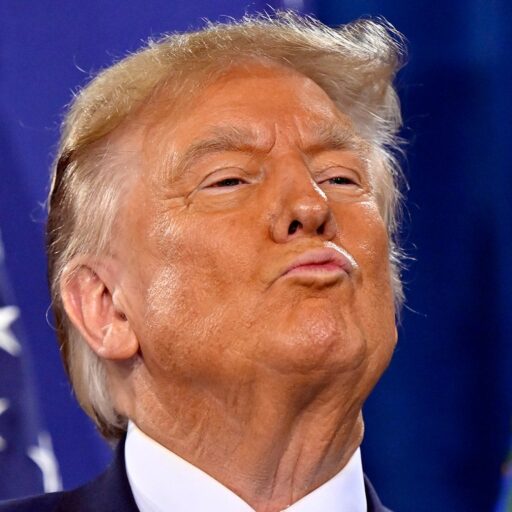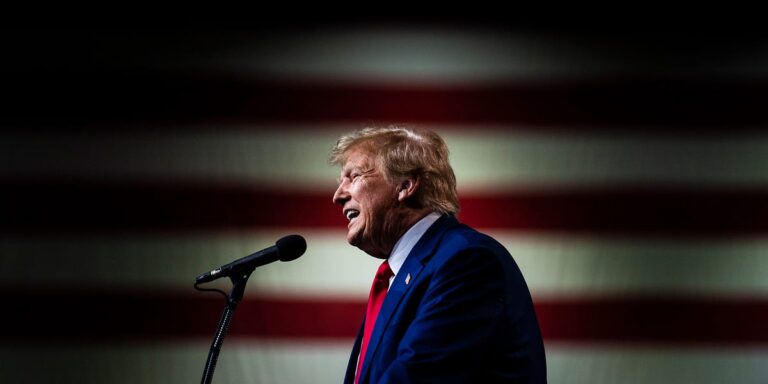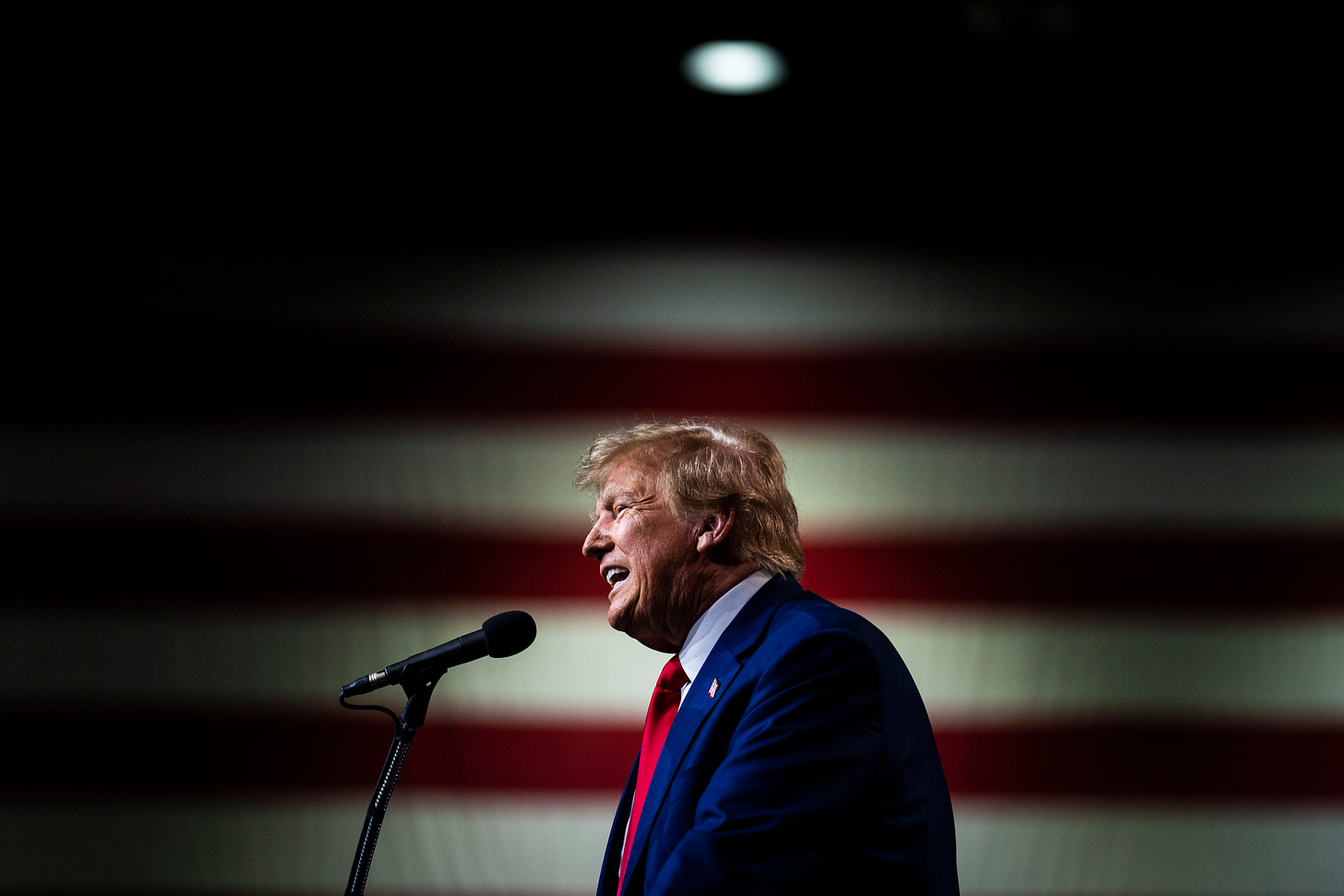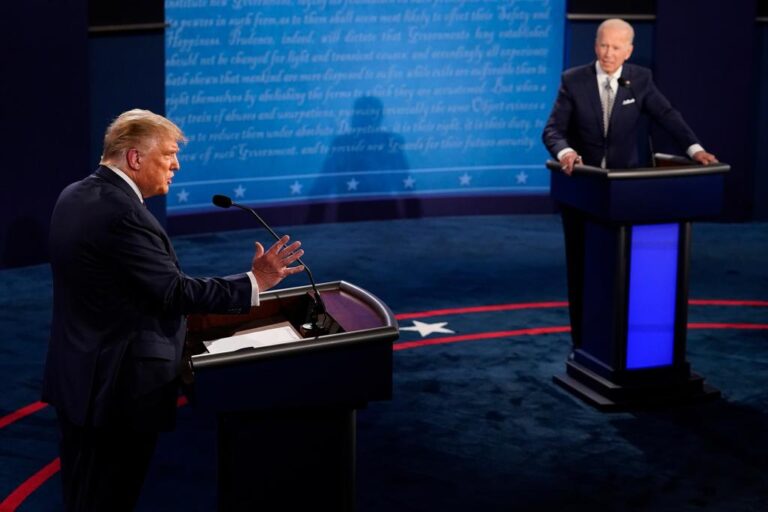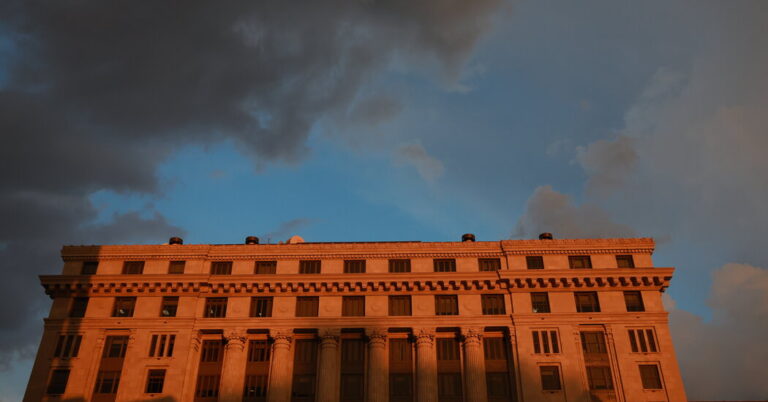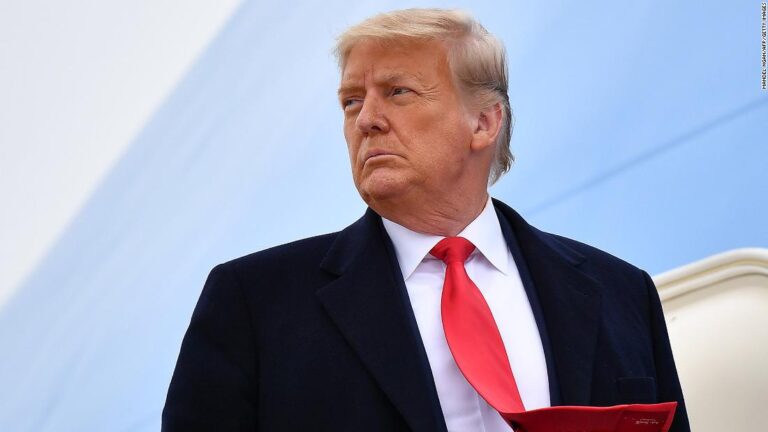President Donald Trump’s onslaught of falsehoods about the November election misled millions of Americans, undermined faith in the electoral system, sparked a deadly riot — and has now left taxpayers with a large, and growing, bill.
The total so far: $519 million.
The costs have mounted daily as government agencies at all levels have been forced to devote public funds to respond to actions taken by Trump and his supporters, according to a Washington Post review of local, state and federal spending records, as well as interviews with government officials. The expenditures include legal fees prompted by dozens of fruitless lawsuits, enhanced security in response to death threats against poll workers, and costly repairs needed after the Jan. 6 insurrection at the Capitol. That attack triggered the expensive massing of thousands of National Guard troops on the streets of Washington amid fears of additional extremist violence.
Although more than $480 million of the total is attributable to the military’s estimated expenses for the troop deployment through mid-March, the financial impact of the president’s refusal to concede the election is probably much higher than what has been documented thus far, and the true costs may never be known.
Many officials contacted by The Post said they were still trying to tally the cost of rapidly scaling up security to deal with the increased threat of violence from Trump supporters. Others have given up on trying to calculate their costs — perplexed over how to calculate the financial impact of a president’s injecting so much instability into the democratic system — opting instead to simply absorb them as the cost of doing business in the Trump era.
Costs identified by The Washington Post related to election misinformation
| Costs associated with Jan. 6 insurrection and inauguration | At least $488,800,000 |
| State costs associated with Jan. 6 and inauguration-related security | At least $28,310,464 |
| State costs related to legal challenges and security for election officials | At least $2,217,905 |
| Total | At least $519,328,369 |
Some officials have shifted their attention to making plans for additional security measures going forward in the threatening environment fostered by Trump’s conspiratorial brand of politics.
“I think anytime you see an event like we saw on January 6th, it changes your perspective going forward. You don’t take things for granted like we used to,” said Michael Rapich, superintendent of the Utah Highway Patrol, which spent $227,000 on Jan. 17 to deploy 300 troopers to the state’s Capitol after threats of an armed siege by Trump supporters ahead of the inauguration of President Biden. “It is an incredible amount of money to spend.”
President Donald Trump speaks at the White House early in the morning on Nov. 4. He’s joined by first lady Melania Trump, Vice President Mike Pence and his wife, Karen Pence.(Jabin Botsford/The Washington Post)
Trump delivers remarks at the White House on Nov. 20.(Jabin Botsford/The Washington Post)
A crowd watches as Trump speaks during an event hosted by the Republican National Committee on Dec. 5 in Valdosta, Ga. (Jabin Botsford/The Washington Post)
Trump talks to reporters before boarding Marine One at the White House on Jan. 12. (Jabin Botsford/The Washington Post)
Other states spent even more, and officials are beginning to draft new security budgets that suggest ongoing security costs will grow significantly in the future as a result of the Capitol breach.
The bill to the federal government continues to grow daily, as thousands of National Guard troops patrol Washington and lawmakers consider a supplemental spending proposal to bolster their security.
The 25,000 troops that were deployed to Washington traveled on military planes and stayed in local hotels — their presence aimed at restoring order in the nation’s capital after an attempted insurrection that overwhelmed Capitol police and ended in five deaths. The cost estimate of the troops, first reported by Bloomberg News, covers the troop presence at the Capitol through mid-March, according to Defense Department officials who spoke on the condition of anonymity to discuss internal figures. With an unprecedented show of force that included checkpoints and militarized zones in Washington, the troops succeeded in thwarting efforts to disrupt Biden’s swearing-in, which took place on the same platform stormed by Trump-supporting rioters two weeks earlier.
Costs associated with Jan. 6 insurrection and after, including inauguration
| National Guard | Cost of deploying as many as 25,000 troops to Washington through mid-March | At least $480,000,000 |
| D.C. police | Cost for a week of added security at the Capitol, including surge of 850 officers on Jan. 6 | At least $8,800,000 |
| Architect of the Capitol | Broken windows, busted doors, landscaping, graffiti and other damage to the Capitol | Unavailable |
| U.S. Park Police | Damage and cleanup of the National Mall | Unavailable |
| U.S. Capitol Police | Additional staffing at the Capitol, overtime, medical bills | Unavailable |
| Subtotal | At least $488,800,000 |
It is not clear whether the House Democrats managing Trump’s impeachment trial plan to bring up the financial costs borne by taxpayers as a result of what critics have called his “big lie.” The trial begins Tuesday, and Democrats have focused heavily on Trump’s speech to supporters shortly before the Capitol riot.
A spokeswoman for Trump’s presidential office did not respond to a request for comment. Trump’s defense lawyers have argued that he was within his rights to publicly question the election’s integrity and should not be held responsible for the actions of people who attacked the Capitol after his speech.
Protesters surround the U.S. Capitol during a joint congressional session to certify the electoral college vote on Jan. 6.(Amanda Voisard for The Washington Post)
Rioters try to gain access to the U.S. Capitol on Jan. 6.(Amanda Voisard for The Washington Post)
A rioter’s face is visible in the broken glass door of the House chamber as security agents point their weapons at him on Jan. 6. (Bill O’Leary/The Washington Post)
Rioters are detained inside the Capitol on Jan. 6. (Amanda Voisard for The Washington Post)
Several states are working to calculate the taxpayer costs for additional security and related expenses in the aftermath of the November election and the Jan. 6 protests.
In California, state officials estimated they spent about $19 million, deploying 1,000 National Guard troops and hundreds of state troopers from Jan. 14 to Jan. 21 to protect the state Capitol and other locations.
“That’s a lot of money, even by California standards, for one week’s worth of work,” California Department of Finance spokesman H.D. Palmer said in an interview. “But it was necessary work to make sure that we didn’t see the damage that could have occurred, had we had a crowd that was bent on doing damage to the building.”
In Ohio, taxpayers spent $1.2 million to deploy National Guard troops to the closed Statehouse building in Columbus. The New Mexico legislature increased its appropriation for Capitol security during the 60-day session by almost 40 percent this month, handing taxpayers a bill of $1.5 million for personnel, equipment and other expenses, officials said.
Taxpayers paid to deploy helicopters to monitor potential demonstrations in Texas and North Carolina, temporary fencing around the capitols in Lansing, Mich., and Olympia, Wash., and extra security details for state lawmakers attending legislative sessions.
D.C. police dispatched 850 officers to help defend the Capitol, spending more than $8.8 million during the week of Jan. 6, acting police chief Robert J. Contee III said in his opening statement before a closed session of the House Appropriations Committee on Jan. 26. Contee said the final tab will probably be much higher, and police and prosecutors will be “engaged for years” investigating and trying the rioters.
“The costs for this insurrection — both human and monetary — will be steep,” he said. “The immediate fiscal impact is still being calculated.”
The Michigan National Guard stands in front of the Capitol building in Lansing on Jan. 17.(Ed Ou for The Washington Post)
Security tightens on Jan. 17 in Harrisburg, Pa., in anticipation of demonstrations ahead of Inauguration Day.
(Katherine Frey/The Washington Post)
Before Inauguration Day, officers from a variety of law enforcement agencies were deployed to protect the Capitol complex in St. Paul, Minn. (Ben Hovland for The Washington Post)
Officers surround the Capitol building in Austin on Jan. 17. (Callaghan O’Hare for The Washington Post)
For many states, the post-Jan. 6 costs added to a tab that has been growing since shortly after polls closed on Nov. 3. Trump’s false assertion that night that he had won the election and that it was being stolen in ballot-processing centers led to credible threats against poll workers and facilities where they were working. Between added legal fees to fend off conspiracy-theory-laced lawsuits from Trump and enhanced security for election officials, states’ costs resulting from the president’s central fabrication about the Nov. 3 vote have escalated rapidly.
States spent untold millions of dollars on election recounts not required by law but demanded by Trump and legal and state legislative hearings.
Protesters, some armed, amassed at ballot-processing centers in places such as Maricopa County, Ariz.; Detroit; and Las Vegas in the days after Nov. 3, echoing Trump’s rhetoric about a rigged election.
The added bill comes as many states are resource-strapped as a result of a pandemic that has wracked the economy and decimated state budgets.
State costs associated with Jan. 6 and pre-inauguration-related security
| Arizona | Security by Maricopa County and Phoenix police for election-related protests | $826,999 |
| California | National Guard and state forces after Jan. 6 rally in Sacramento and ahead of Inauguration Day | $19,000,000 |
| Colorado | Security and fencing after 700 demonstrators gathered in Denver, and ahead of Inauguration Day | $62,775 |
| Florida | Florida Department of Law Enforcement security ahead of Inauguration Day | $27,300 |
| Georgia | National Guard activated, state SWAT team patrolled Capitol | Unavailable |
| Minnesota | National Guard and local forces mobilized after 500 demonstrators rallied at Capitol | Unavailable |
| New Mexico | Legislature appropriated additional funding for security during 60-day legislative session | $416,957 |
| New York | Additional state police deployed to Capitol after protests | Unavailable |
| North Carolina | National Guard troops deployed to State Legislative Building | $605,251 |
| Ohio | National Guard troops deployed to Statehouse after protests | $1,225,000 |
| Oregon | National Guard troops mobilized to support state police after protests | Unavailable |
| Pennsylvania | National Guard troops and state police deployed to Capitol and elsewhere ahead of inauguration | $565,631 |
| South Carolina | State troopers and Richland County sheriff’s deputies deployed to State House ahead of inauguration | $414,934 |
| Texas | National Guard troops and state troopers mobilized to protect Capitol after protests and ahead of inauguration | Unavailable |
| Utah | National Guard troops and state troopers mobilized to Salt Lake City ahead of inauguration | $585,000 |
| Washington | National Guard troops and state police mobilized to Capitol after protests | $3,987,617 |
| Wisconsin | National Guard troops mobilized to Madison after protests | $593,000 |
| Subtotal | At least $28,310,464 |
Chris Loftis, communications director for the Washington State Patrol, said the new “staggeringly high” costs for security and other expenses constituted “a wasteful distraction of essential and diminishing resources.”
Not included in the more than $4 million estimated security bill for Washington state taxpayers is the yet-to-be-determined cost of fixing a gate at the governor’s mansion broken by armed demonstrators on Jan. 6.
“Not only have our people, places and processes of democracy been attacked and damaged, but the continuing expense of this new security environment will take away from funds that could have been used for covid vaccines and treatment” and other critical expenses, Loftis said.
Election challengers demand to observe absentee-ballot counting but were denied entry after the room reached capacity in Detroit on Nov. 4.(Salwan Georges/The Washington Post)
Jessica Lehman files a ballot after it was double-checked at the Allegheny County elections warehouse in Pittsburgh on Nov. 6.(Michael S. Williamson/The Washington Post)
Election workers perform a recount of Milwaukee County’s results on Nov. 20.(Taylor Glascock for The Washington Post)
Cobb County election workers recount votes by hand in Marietta, Ga., on Nov. 13. (Kevin D. Liles for The Washington Post)
In Georgia, which faced a large share of Trump’s post-election fraud charges, officials conducted two recounts of the presidential vote. One was triggered by Biden’s narrow margin of victory over Trump, leading to a hand recount of all 5 million presidential ballots cast — the largest hand recount in U.S. history. The Trump campaign then requested another recount — this time, a machine rescan of those hand-recounted ballots. Both recounts reaffirmed Biden’s victory. They also added extra costs for staff time and the security of election administrators, who faced growing threats and, in some cases, required 24-hour police details.
In Fulton County, Georgia’s largest, taxpayers spent an estimated $500,000 on security alone for election officials, who faced harassment and threats fueled by conspiracy theories over the November election.
Other state and local officials spent funds to battle with Trump’s well-funded team of lawyers in court. Trump and his allies devoted more than $11 million to a failed legal effort that included dozens of lawsuits and repeated losses in court due to a lack of evidence. After the Nov. 3 election and through the end of December, Trump and the Republican Party paid at least 65 firms or lawyers on election-related legal challenges, according to federal campaign finance filings.
Costs related to state legal challenges and security for election officials
In Georgia, separate figures for the Trump-requested recount were not available as of deadline.
| Arizona | Election lawsuits | At least $153,862 |
| Georgia | Election-related security | At least $500,000 |
| Michigan | Election lawsuits, security | Unavailable |
| Minnesota | Election lawsuits | $35,620 |
| Nevada | Election lawsuits | Unavailable |
| New Mexico | Election lawsuits | Unavailable |
| Pennsylvania | Election lawsuits | $1,528,423 |
| Texas | Election lawsuits | Unavailable |
| Wisconsin | Election lawsuits | Unavailable |
| Subtotal | At least $2,217,905 |
The state of Pennsylvania hired several private law firms to deal with the onslaught of election litigation, paying outside lawyers as much as $480 per hour to fight Trump’s claims of rigged voting.
How much taxpayers ultimately had to spend to beat back Trump’s efforts to delay certification or overturn the results remains unknown, because many state officials did not specifically track their legal expenses.
“Although difficult to quantify, many legal hours were invested by the secretary of state’s general counsel and attorneys with the New Mexico attorney general’s office in responding to the baseless lawsuit filed by the Trump campaign,” said Alex Curtas, a spokesman for the New Mexico secretary of state.
Many officials said that while they wished the cost incurred as a result of Trump’s baseless voter-fraud allegations could have gone to more productive purposes, they saw the expenses as necessary to defending democracy.
“Safety isn’t cheap. Preparedness isn’t cheap,” Loftis said. “But neither are the lives of the elected leaders and support staff that we have been protecting, the historic and symbolic buildings they work in or the processes of democracy they represent.”
Congress is also grappling with calculating the expected costs of cleaning up and shoring up the Capitol after rioters carrying Trump flags and wearing MAGA hats smashed windows, busted doors, destroyed light fixtures and sprayed graffiti. The hours-long clash between law enforcement and insurrectionists left the building with battle scars that could take months to assess and repair, officials said.
National Guard troops and various law enforcement agencies were out in full force during rehearsals for Inauguration Day on Jan. 18.(Michael Robinson Chavez/The Washington Post)
Cleaners remove debris from artwork on Jan. 12.(Melina Mara/The Washington Post)
An office is seen in disarray on Jan. 15 following the riot at the Capitol.(Salwan Georges/The Washington Post)
Plastic covers a statue at the Capitol on Jan. 7.(Bonnie Jo Mount/The Washington Post)
“Statues, murals, historic benches and original shutters all suffered varying degrees of damage — primarily from pepper spray accretions and residue from tear gas and fire extinguishers — that will require cleaning and conservation,” according to an initial assessment of the damage by the office of the architect of the Capitol, which is responsible for preserving and maintaining the Capitol complex.
An official estimate for repair and cleanup costs is still being compiled, said Laura Condeluci, a spokeswoman for the office.
Congressional officials are also trying to determine the costs for securing the Capitol going forward. House Speaker Nancy Pelosi (D-Calif.) requested a third-party review of security protocols for lawmakers and said she expected Congress to put forward a supplemental spending bill specifically for beefing up security for lawmakers. The $515 million annual budget of the Capitol Police is funded through congressional appropriations.
The agency, which did not respond to multiple requests for comment about how much the Jan. 6 riot cost, has placed many of its officers on 12-hour shifts and installed magnetometers and other additional security measures in recent weeks to deal with the increased threat of violence against lawmakers.
Acting Capitol Police chief Yogananda Pittman said in a Jan. 28 statement that “vast improvements” were needed for security in the future, including permanent fencing and backup forces in the vicinity of the Capitol complex.
The idea of creating a fence around the Capitol has received pushback from some congressional leaders and D.C. Mayor Muriel E. Bowser (D), but it could ultimately be an expensive prospect if approved. The recent project to replace and upgrade the fencing around the White House complex, for example, cost about $64 million.
In the meantime, members of Congress are taking additional security measures on their own, ranging from bulletproof vests to private security details and surveillance cameras. Taxpayers are ultimately footing the bill, as lawmakers increasingly use their publicly funded Members’ Representational Allowances, known as “MRAs,” to protect themselves.
Pelosi has suggested that she wants the supplemental spending bill to cover much of those costs, so members can use the MRAs for their original purpose of serving constituents.
Pelosi has also encouraged lawmakers to attend post-traumatic counseling sessions organized in response to the riot. A spokesman for Pelosi did not respond to questions seeking the cost of the third-party security review, the counseling sessions or other ancillary expenses in the aftermath of Jan. 6.
Whatever their costs, those and other measures are expected to only grow over time as lawmakers deal with what the Department of Homeland Security recently described in a bulletin as a “heightened threat environment” in which domestic extremists may act on “perceived grievances fueled by false narratives.”
Robert McCrie, who teaches security management at the John Jay College of Criminal Justice, compared the circumstances to the aftermath of the terrorist attacks on Sept. 11, 2001, which led to a range of permanent security measures and expenses that have continued for almost 20 years.
“There’s no going back,” he said. “Our institutions have to be protected. They’re symbolic, but more than that, they are centers of government, of our sense of having a stable society. So those funds have to be spent.”
Heightened security is seen in front of the Capitol on Inauguration Day. (Matt McClain/The Washington Post)
National Guard troops stand around the secure zone of the Capitol on the morning of Inauguration Day.(Melina Mara/The Washington Post)
Soldiers rest in the Capitol Visitor Center on Jan. 13. (Bill O’Leary/The Washington Post)
National Guard members stand on the steps of the Capitol during a ceremony on Feb. 5.(Salwan Georges/The Washington Post)
Federal investigators have also devoted considerable time and resources to identifying, finding and prosecuting rioters who breached the Capitol and threatened lawmakers; an officer also died after suffering injuries in the attack, and dozens of others were wounded.
U.S. authorities have opened case files on more than 400 potential suspects and obtained more than 500 grand jury subpoenas and search warrants in the sprawling investigation, acting U.S. attorney Michael R. Sherwin told reporters Jan. 26.
A nationwide manhunt has already resulted in 135 arrests and 150 federal criminally charged cases, according to Sherwin, the top prosecutor in D.C.
More charges could follow.
Law enforcement officials have estimated that roughly 800 people entered the Capitol without authorization, The Post reported last month.
The FBI and Justice Department declined to comment on the costs of the prosecutions and investigations, but some inside the bureau have described the Capitol riot case as their biggest since the Sept. 11, 2001, attacks.
Loftis, the Washington State Patrol spokesman, has said he has the full backing of his agency’s leadership to speak out.
“The selfish madness that caused this national self-inflicted wound must be addressed, as it has heaped tragedy on top of tragedy,” he said. “If those of us in law enforcement don’t speak up in defense of democracy and public safety, then our silence becomes a dreadfully powerful statement in its own right.”



